
The town of Hillsborough is the county seat of Orange County, North Carolina, United States and is located along the Eno River. The population was 6,087 in 2010, but it grew rapidly to 9,660 by 2020.

The North Carolina State Capitol is the former seat of the legislature of the U.S. state of North Carolina which housed all of the state's government until 1888. The Supreme Court and State Library moved into a separate building in 1888, and the General Assembly moved into the State Legislative Building in 1963. Today, the governor and his immediate staff occupy offices on the first floor of the Capitol.
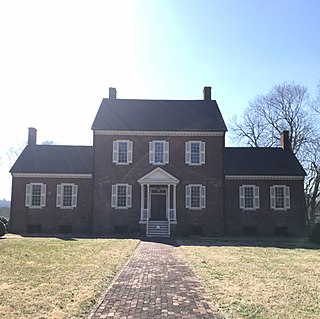
Ayr Mount is a Federal style plantation house located east of Hillsborough, in Orange County, North Carolina, the United States of America.

The Nash-Hooper House, also known as the William Hooper House, is a historic house at 118 West Tryon Street in Hillsborough, North Carolina. Built in 1772 by American Revolutionary War general Francis Nash, it was home from 1782–1790 to Founding Father William Hooper, a signer of the United States Declaration of Independence. It is the only known home of Hooper's to survive, and was declared a National Historic Landmark in 1971. It is located in the Hillsborough Historic District; it is a private residence, and is not normally open to the public.

The Masonic Temple Building located at 133 Fayetteville Street in Raleigh, North Carolina was the state's first reinforced concrete skyscraper. Constructed in 1907 by Grand Lodge of North Carolina, the building represents the growth of Raleigh in the early 20th century and rise of the influence of Masons. The Masonic Temple Building was added to the National Register of Historic Places in 1979 and is a Raleigh Historic Landmark.

Warrenton Historic District is a national historic district located at Warrenton, Warren County, North Carolina. The district encompasses 202 contributing buildings in the central business district and surrounding residential sections of Warrenton. The district developed between about 1840 and 1926, and includes notable examples of Early Republic, Greek Revival, and Late Victorian architecture. Notable buildings include the Falkener House, Macon Street House, Peter Davis Store, Jones-Cook House, Eaton Place (1843), Sommerville-Graham House by Jacob W. Holt, Presbyterian Church also by Holt, Baptist Church, Methodist Episcopal Church, Miles Hardware Store, Warrenton City Hall, Warrenton Hotel, John Graham School, and the U.S. Post Office.

Hillsborough Historic District is a national historic district located at Hillsborough, Orange County, North Carolina. The district encompasses 529 contributing buildings, 9 contributing sites, 13 contributing structures, and 2 contributing objects in the central business district and surrounding residential sections of Hillsborough. The district includes buildings dating to the late-18th and early-20th century and includes notable examples of Federal, Greek Revival, and Italianate style architecture. Located in the district are the separately listed Burwell School, Eagle Lodge, Hazel-Nash House, Heartsease, Montrose, Nash Law Office, Nash-Hooper House, Old Orange County Courthouse, Poplar Hill, Ruffin-Roulhac House, Sans Souci, and St. Matthew's Episcopal Church and Churchyard. Other notable buildings include Seven Hearths, the Presbyterian Church (1815-1816), Methodist Church (1859-1860), First Baptist Church (1862-1870), Twin Chimneys, and the Berry Brick House.
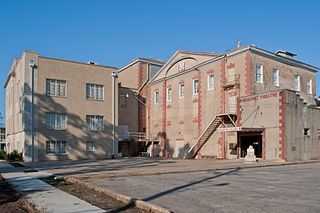
The Masonic Temple, also known as St. John's Lodge No. 3, A.F. & A.M., is a historic Masonic temple and theatre located at 516 Hancock Street in New Bern, Craven County, North Carolina. It was built between 1802 and 1809, with additions and several alterations. The original section is a very tall, two-story Federal style brick structure, seven bays wide by four bays deep. It sits on a high basement and has a hipped roof. A major addition was made in 1904, and the building was remodeled in 1847 and in 1917. The site was the scene of a duel in 1802.

St. Matthew's Episcopal Church and Churchyard is a historic Episcopal church located on St. Mary's Road, Hillsborough, Orange County, North Carolina. The first three bays of the Gothic Revival-style brick church were built between 1825 and 1826, and its rear was extended by another bay in 1868. It features a square entrance tower built in 1830, which was rebuilt in 1850. The tower has a pyramidal spire and lancet windows.

Pittsboro Masonic Lodge, also known as Columbus Lodge No. 102, is a historic Masonic Lodge located at Pittsboro, Chatham County, North Carolina. It was built in 1838, and is a two-story, Greek Revival style frame building. In 1846, it was enlarged by the addition of the distinctive pedimented second-story overhang carried on heavy square pillars. It is one of the oldest still-functioning Masonic halls in North Carolina.
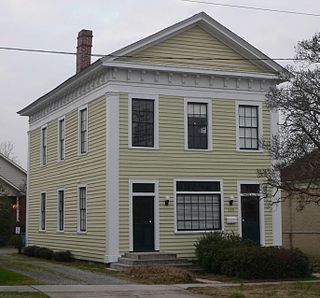
Smithfield Masonic Lodge, also known as the Brooks Building, is a historic Masonic Lodge located at Smithfield, Johnston County, North Carolina, United States It is believed to be built in about 1854, and had moved to its present location in 1915–1917. It is a two-story, three-bay, rectangular vernacular Greek Revival style frame building. It has a gable front temple form and is sheathed in plain weatherboard. Fellowship Lodge No. 84 occupied the building until the 1940s, and the Smithfield Woman's Club met in the building from 1917 through 1933. The building house Smithfield's first public library operated by the Smithfield Woman's Club.

Sans Souci is a historic home located at Hillsborough, Orange County, North Carolina. It was built about 1813, as two-story, three-bay, frame dwelling with a gable roof and set on a brick foundation. Later additions included 1+1⁄2-story flanking wings added in the Federal period and a Greek Revival shed addition built in the mid-19th century across the rear of the main block and the east wing. Also on the property are the contributing kitchen, office, and servant's quarters.

Hazel-Nash House, also known as the Hasell-Nash House, is a historic home located at Hillsborough, Orange County, North Carolina. It was built about 1820, and consists of a two-story, three-bay, pedimented central block flanked by a pair of pedimented single-story wings. The front facade features a single-story porch supported by Ionic order columns and a central Palladian window. Its design is probably based on Robert Morris (1703–1754) plate 37 of his Rural Architecture..
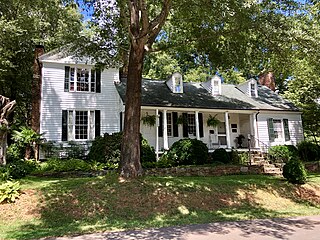
Heartsease is a historic home located at Hillsborough, Orange County, North Carolina. It was built about 1770, and consists of a 1+1⁄2-story, three-bay, central block dating to the late 18th century, with an early 19th-century 1+1⁄2-story east wing, and two-story pedimented west wing added in the late 19th century. It is topped by a gable roof and features a shed porch whose roof supported by plain Tuscan order posts. It is believed that Heartsease served as the pre-Revolutionary home of Thomas Burke, North Carolina's third governor and a member of the Constitutional Convention.

Ruffin-Roulhac House, also known as Little Hawfields, is a historic home located at Hillsborough, Orange County, North Carolina, United States. It was built about 1820, and is a 1+1⁄2-story, five bay, frame dwelling including a two-room addition built about 1830. It is topped by a gable roof, is sheathed in weatherboard, and has a one-bay 20th century replacement porch. The interior has Federal, Greek Revival, and Victorian style design elements. It was the home of jurist Thomas Ruffin (1787–1870) from after the end of the American Civil War until his death in 1870.

Moorefields is a historic plantation home located near Hillsborough, Orange County, North Carolina. It was built about 1785, and consists of a two-story central block, three bays wide, with flanking one-bay wings in the Federal style. The house features a shed porch with turned wooden posts. It was built by soldier and judge Alfred Moore (1755-1810).

Nash Law Office is a historic office building located at Hillsborough, Orange County, North Carolina. It was built in 1801, and is a small one-story, frame building with a gable roof and low brick foundation. It has a brick exterior end chimney and a small one-story wing added in 1865. The building housed the law office of jurist Frederick Nash (1781-1858). Following his death it housed a school and was purchased by the Hillsborough Historical Society in 1970.
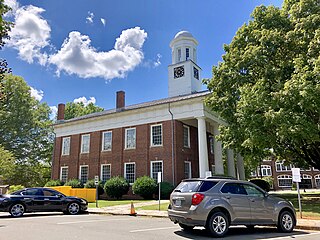
Old Orange County Courthouse is a historic courthouse building located at Hillsborough, Orange County, North Carolina. It was built in 1845, and is a two-story, Greek Revival style, temple-form brick structure. It replaced Dickerson Chapel as the county's courthouse. The front facade features a Doric order tetrastyle pedimented portico and two-stage clock tower. The building served as the seat of Orange County's government until 1954, when a new building was completed.

Holly Springs Masonic Lodge is a historic Masonic Lodge located at Holly Springs, Wake County, North Carolina. It was built about 1852, and is a two-story, Greek Revival influenced frame building with a side gable roof. It has a one-story, hip roofed front porch. In addition to being a Masonic Lodge, the building also housed a school.























